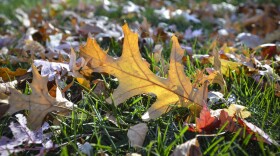-
A national survey found the smallest business owners are feeling less confident as they close out the year. Inflation, tariffs and shifts in consumer spending are some of the reasons why.
-
Are you serving pumpkin or sweet potato pie this Thanksgiving? There's a lot of history and cultural ties that influence why Americans may prefer one or the other.
-
Scientists say leaving autumn leaves on the ground can add important nutrients to the soil and create needed habitat for insects.
-
Coffee has gotten a lot more expensive in the U.S. as tariffs seep into the price tag. Even as the Trump administration considers offering some tariff relief, that's putting a strain on roasters, who have no choice but to pass on some of the extra cost to coffee drinkers.
-
Food assistance benefits were cut off in November due to the government shutdown. That’s led a handful of state agencies to post messages blaming Republicans or Democrats for the shutdown on official websites.
-
The U.S. agricultural industry depends on undocumented immigrants, but President Trump’s immigration crackdown is further depleting an already tight workforce. The labor crisis may be setting the stage for big changes to a federal program that allows foreign workers into the country legally.
-
Turkey prices tend to rise closer to holidays such as Thanksgiving. But tariffs and bird flu could dramatically drive up the cost of turkeys this year.
-
Temperatures remained into the 80s well in the fall this year in parts of the Midwest. Agrivoltaics offers a respite to extreme heat and land access for new farmers.
-
Some Midwestern soybean farmers are selling their beans to be crushed and turned into soybean meal and oil. But economists say domestic processing won’t be enough to offset the drop in Chinese demand.
-
Food bank staff expect a wave of new demand as millions of Americans are set to lose federal food assistance in November. But they insist that their services alone won’t be enough to feed everyone who relies on the Supplemental Nutrition Assistance Program.
-
Bats love to munch on insects like stink bugs and moths. Some farmers are now relying on the mammals for pest control – and ditching chemicals.
-
El cierre del Gobierno impide la administración de los subsidios agrícolas por parte del Departamento de Agricultura de los Estados Unidos, (USDA) lo cual amenaza con un aumento de los juicios hipotecarios de las granjas. También retrasa la ayuda financiera que el presidente Trump había prometido a los agricultores afectados por los aranceles.















